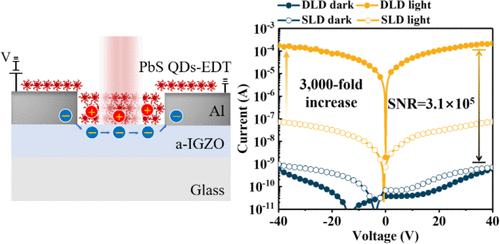当前位置:
X-MOL 学术
›
ACS Photonics
›
论文详情
Our official English website, www.x-mol.net, welcomes your
feedback! (Note: you will need to create a separate account there.)
High-Performance Photodetector with a-IGZO/PbS Quantum Dots Heterojunction
ACS Photonics ( IF 6.5 ) Pub Date : 2023-02-23 , DOI: 10.1021/acsphotonics.3c00086 Cong Zhang 1 , Xingtian Yin 1 , Gaocheng Chen 1 , Zi Sang 1 , Yawei Yang 1 , Wenxiu Que 1
ACS Photonics ( IF 6.5 ) Pub Date : 2023-02-23 , DOI: 10.1021/acsphotonics.3c00086 Cong Zhang 1 , Xingtian Yin 1 , Gaocheng Chen 1 , Zi Sang 1 , Yawei Yang 1 , Wenxiu Que 1
Affiliation

|
Low cost, high absorption coefficient, tunable band gap, and compatibility with flexible devices make lead sulfide (PbS) quantum dots (QDs) based photoconductors promising candidates for next-generation near-infrared (NIR) photodetectors. However, the detection performance of PbS QDs-based photoconductors still needs to be further improved, because there is a trade-off among the responsivity/detectivity/bandwidth in the device development process, that is, it is difficult to improve the three parameters simultaneously. Inspired by the design idea of sensitized phototransistor, a kind of amorphous indium gallium zinc oxide (a-IGZO)/PbS QDs heterojunction photoconductor is reported in this paper. The most prominent feature of this work is that a-IGZO, like a photocurrent “amplifier”, increases the photocurrent by several orders of magnitude without generating additional noise, and thus improves the sensitivity and responsiveness of the device. Compared with the initial pure PbS QDs-based photoconductor, the heterojunction device is able to increase the photocurrent by 3000 times together with a low dark current, and improve the response speed of the device with the help of interface-assisted carrier separation and recombination. In the NIR band, the device exhibits an exciting performance with a detectivity of 1.53 × 1013 Jones, a responsivity of 19070 mA/W and a decay time of 0.39 ms, respectively. By applying the a-IGZO/PbS QDs heterojunction to paper-based devices, a flexible device with bending resistance can be obtained, and the detection performance of the device does not deteriorate after 1000 times of bending.
中文翻译:

具有 a-IGZO/PbS 量子点异质结的高性能光电探测器
低成本、高吸收系数、可调带隙以及与柔性设备的兼容性使得基于硫化铅 (PbS) 量子点 (QD) 的光电导体有望成为下一代近红外 (NIR) 光电探测器的候选者。然而,基于PbS QDs的光电导体的检测性能仍需进一步提高,因为在器件开发过程中响应度/检测度/带宽之间存在权衡,即很难同时提高三个参数. 受敏化光电晶体管设计思想的启发,本文报道了一种非晶氧化铟镓锌(a-IGZO)/PbS QDs异质结光电导体。这项工作最突出的特点是a-IGZO,就像一个光电流“放大器”,在不产生额外噪声的情况下将光电流增加几个数量级,从而提高了器件的灵敏度和响应能力。与最初的纯PbS QDs基光电导体相比,异质结器件能够将光电流提高3000倍,暗电流较低,并借助界面辅助载流子分离和复合提高器件的响应速度。在 NIR 波段,该器件表现出令人兴奋的性能,检测率为 1.53 × 10 并借助界面辅助载流子分离重组提高器件的响应速度。在 NIR 波段,该器件表现出令人兴奋的性能,检测率为 1.53 × 10 并借助界面辅助载流子分离重组提高器件的响应速度。在 NIR 波段,该器件表现出令人兴奋的性能,检测率为 1.53 × 1013 Jones,响应度分别为 19070 mA/W 和衰减时间 0.39 ms。将a-IGZO/PbS QDs异质结应用到纸基器件上,可以获得具有抗弯折能力的柔性器件,且器件的检测性能在1000次弯曲后仍不退化。
更新日期:2023-02-23
中文翻译:

具有 a-IGZO/PbS 量子点异质结的高性能光电探测器
低成本、高吸收系数、可调带隙以及与柔性设备的兼容性使得基于硫化铅 (PbS) 量子点 (QD) 的光电导体有望成为下一代近红外 (NIR) 光电探测器的候选者。然而,基于PbS QDs的光电导体的检测性能仍需进一步提高,因为在器件开发过程中响应度/检测度/带宽之间存在权衡,即很难同时提高三个参数. 受敏化光电晶体管设计思想的启发,本文报道了一种非晶氧化铟镓锌(a-IGZO)/PbS QDs异质结光电导体。这项工作最突出的特点是a-IGZO,就像一个光电流“放大器”,在不产生额外噪声的情况下将光电流增加几个数量级,从而提高了器件的灵敏度和响应能力。与最初的纯PbS QDs基光电导体相比,异质结器件能够将光电流提高3000倍,暗电流较低,并借助界面辅助载流子分离和复合提高器件的响应速度。在 NIR 波段,该器件表现出令人兴奋的性能,检测率为 1.53 × 10 并借助界面辅助载流子分离重组提高器件的响应速度。在 NIR 波段,该器件表现出令人兴奋的性能,检测率为 1.53 × 10 并借助界面辅助载流子分离重组提高器件的响应速度。在 NIR 波段,该器件表现出令人兴奋的性能,检测率为 1.53 × 1013 Jones,响应度分别为 19070 mA/W 和衰减时间 0.39 ms。将a-IGZO/PbS QDs异质结应用到纸基器件上,可以获得具有抗弯折能力的柔性器件,且器件的检测性能在1000次弯曲后仍不退化。












































 京公网安备 11010802027423号
京公网安备 11010802027423号